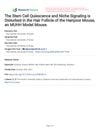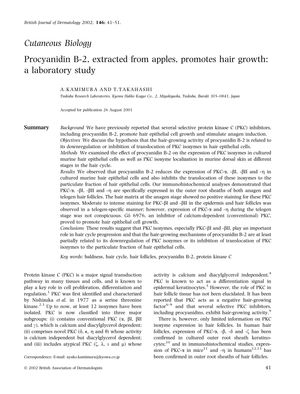TLDR Apple extract called procyanidin B-2 was found to greatly increase hair growth.
In the 2002 study by A. Kamimura and T. Takahashi, procyanidin B-2, extracted from apples, was found to significantly promote hair growth in murine hair epithelial cells. The compound led to a 300% increase in cell growth over a 5-day culture period compared to controls and was observed to reduce the expression of protein kinase C (PKC) isozymes PKC-α, -βI, -βII, and -n. The study concluded that procyanidin B-2's hair growth-promoting mechanisms might be due to its downregulation of PKC isozymes or inhibition of their translocation, suggesting that PKC isozymes play a crucial role in hair cycle progression. The study implies that procyanidin B-2 could be a potential agent for hair growth promotion, although the sample size and whether the study involved humans or animals were not specified.
45 citations
,
September 2001 in “Journal of Investigative Dermatology” Cyclosporin A promotes hair cell growth and affects protein kinase C levels.
 32 citations
,
January 2000 in “Skin pharmacology and physiology”
32 citations
,
January 2000 in “Skin pharmacology and physiology” Certain substances that block a specific protein help promote hair growth.
135 citations
,
October 1999 in “Journal of Cell Science” Overexpressing PKCα in mice skin increases inflammation but doesn't affect tumor growth.
 79 citations
,
March 1999 in “The journal of investigative dermatology/Journal of investigative dermatology”
79 citations
,
March 1999 in “The journal of investigative dermatology/Journal of investigative dermatology” Procyanidin compounds from grape seeds were found to significantly increase mouse hair growth.
38 citations
,
March 1997 in “Journal of interferon & cytokine research” IL-1β inhibits human hair follicle growth.
 11 citations
,
January 1997 in “Skin Pharmacology and Physiology”
11 citations
,
January 1997 in “Skin Pharmacology and Physiology” A certain inhibitor can slow down the decrease in DNA creation in mouse hair follicles, which might help with hair growth.
 October 2021 in “Research Square (Research Square)”
October 2021 in “Research Square (Research Square)” Hair follicle stem cells in hairpoor mice are disrupted, causing hair loss.
45 citations
,
April 2001 in “The journal of investigative dermatology/Journal of investigative dermatology” Different Myc family proteins are located in various parts of the hair follicle and may affect stem cell behavior.
10 citations
,
October 2000 in “PubMed” E6/E7 oncogenes in hair follicles cause continuous hair growth by skipping the resting phase.
69 citations
,
May 1997 in “Veterinary Pathology” The angora mouse mutation causes long hair and hair defects due to a gene deletion.




